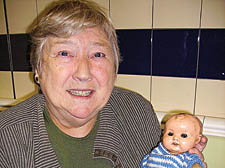|
|
 |
| |

Roz Tankard returns to the Tube where she sheltered as a child with her doll |
The heat of bodies, the smells… and just a doll for comfort as bombs fell in streets above Tube station
Pensioner recalls how as a six-year-old in the Blitz she took refuge in the underground
MEMORIES of the Blitz flooded back for Roz Tankard from Archway as she recalled how as a six-year-old she took refuge in the Underground to avoid bombing raids.
Most of all, she remembers the heat of bodies and the smells. She still has the little doll she clutched for comfort during those terrifying times.
Roz spoke about her experiences following historian David Welsh’s appeal in the Tribune for wartime memories. Her story is among many to be included in a new book about life in the Tube system during the war which is being compiled on behalf of the TUC library collection.
One night in 1940, Roz and her family took shelter at Essex Road underground station after a 1,000-pound unexploded bomb fell on St James’s Church in Bishop Street, where they lived.
As Roz attempted to close her eyes to sleep, a landmine exploded above, killing dozens of people and destroying hundreds of homes.
“You couldn’t hear the bomb going off above us,” she said. “But when we came up in the morning we were told that various people we knew had been killed or injured in the blast.”
Each day as the sirens sounded people queued in their hundreds to descend into Essex Road Tube station carrying bedding and food.
Roz remembers how on one afternoon she insisted she went with her mother to collect her grandfather’s pipe, which he had left at home in the rush to get below.
They hurried out of the station as people were going down, dodged under a cordon and retrieved the pipe. But suddenly the bombing began and they couldn’t get back into the station. Roz was forced to spend several frightening hours holding onto her mother as they took shelter in a house.
Now 73, Roz, a retired civil service admin secretary, lives in Hornsey Lane, Archway. She told her story to Mr Welsh, an oral historian from King’s Cross who is compiling the history.
He explained that at first the government of the day refused permission for people to use the Tube shelters.
“The authorities thought it would cause panic and disrupt the trains,” he said. “But people would defy the rules and buy a rail or platform ticket and get down that way.
“The Communist Party in the East End led demonstrations at station entrances demanding that people be allowed down.
“The CP argued that the public shelters were not adequate and terribly unsafe. The government finally gave in.
“The deep Tube stations were the safest places to be during bombing. Holborn was popular as was Camden Town, Hampstead and Belsize Park. Swiss Cottage had its own shelter committee and newsletter.”
Mr Welsh added: “In the end the Home Secretary realised that if they continued to stop people going down there would be massive disobedience.
“But not all stations were safe. Bounds Green was hit by a bomb and a number of people killed. There was also a big disaster at Bethnal Green where people ran down the steps and died in the crush.”
• Do you have experiences of life on the London Underground during the war? Contact David Welsh on 7837 0845, email davidwelsh83@btinternet.com or write to him at 15 Wellington Road, Norwich NR2 3HT. |
 |
|
| |
| Your Comments: |
| |
| |
| |
|
 |
|